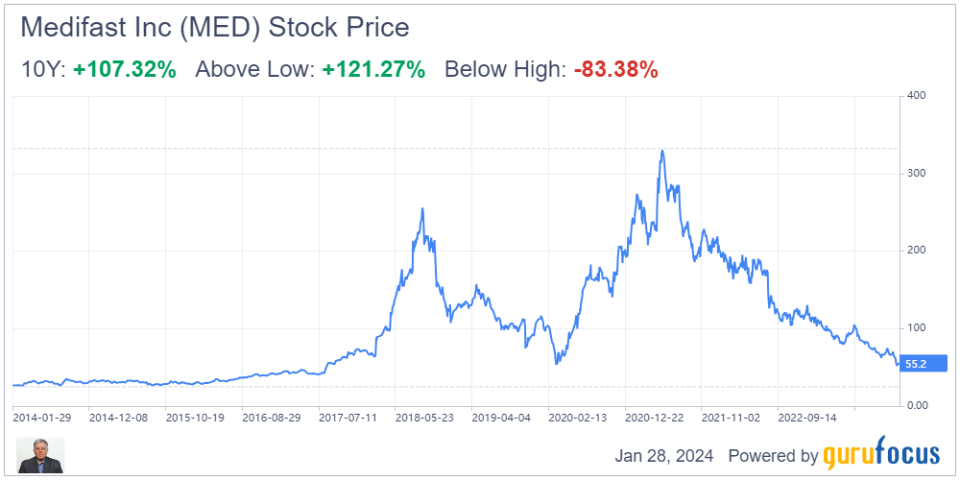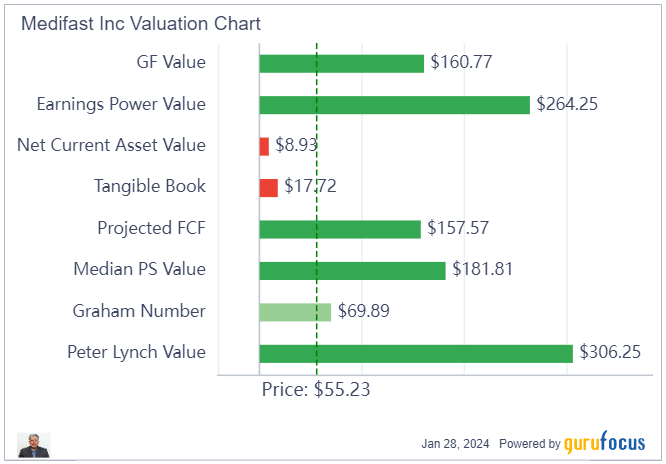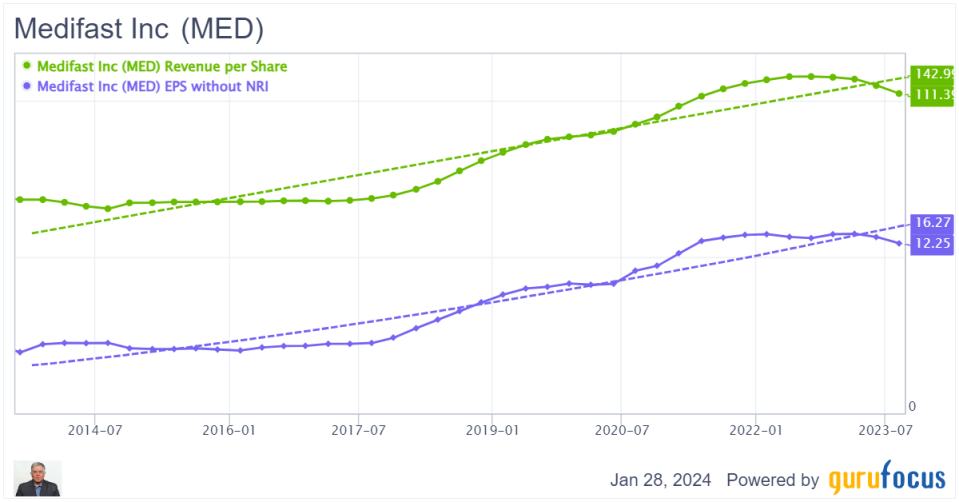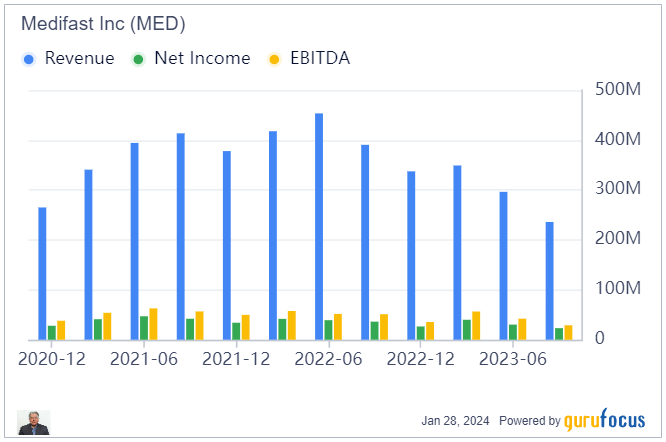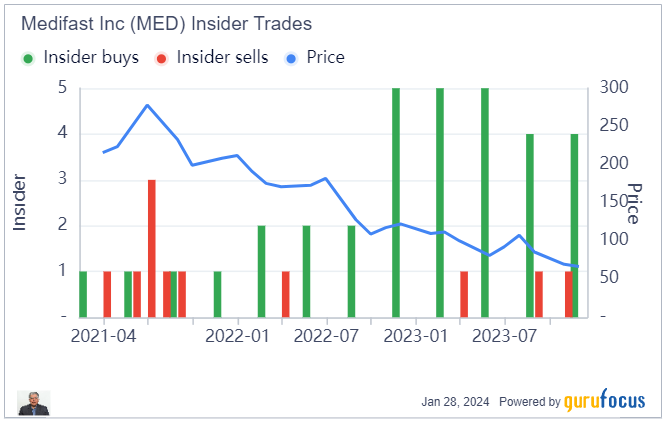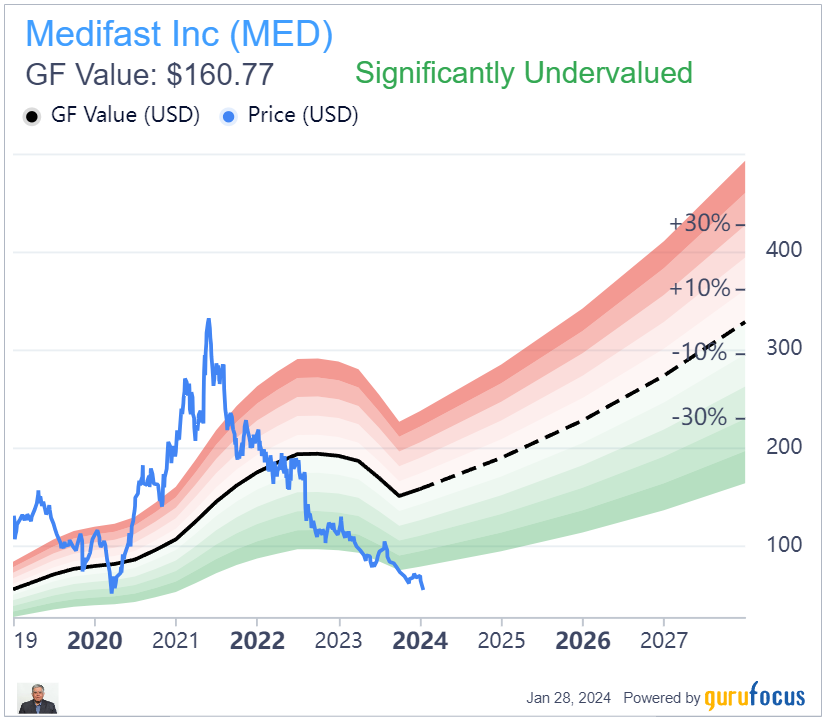A Closer Look at the Disruption of Medifast
Weight loss and wellness product company Medifast Inc. (NYSE:MED) has experienced a significant decrease in market cap recently. The stock is down over 80% since its peak in 2021. This discussion attempts to explain what is going on and assess if there is any prospect for recovery.
On the surface, Medifast's valuation numbers show exceptional value with a price-earnings ratio of only 5.03 and a PEG ratio of 0.11, as does the GuruFocus valuation chart below. Growth of both revenue and income has also been exceptional until recently.
Business model
Medifast sells diet replacement products through self-employed and commissioned "coaches," who are enterpreneurial individuals working to sell products to their community members. The company's business model relies on recruiting coaches to sell their program (branded Optavia) and products, which has been successful in generating revenue and dividends for investors. It is a multi-level marketing (MLM) selling model, otherwise known as network or referral marketing, which is a strategy in which businesses sell their products through person-to-person sales.
The coaches are paid based on their performance and the number of clients they have. They are compensated for client acquisition, team building and sponsorship. They can also earn money through client bonuses, team growth bonuses, leadership bonuses and client support commissions, among other areas. Medifast coaches build their team by recruiting new clients and other coaches. They also focus on building a community of like-minded individuals who share a passion for promoting health and wellness and Medifast diet and nutritional products. Basically, these coaches are selling Medifast nutritional products to their clients. The products themselves are quite expensive and sport high gross margins of over 70%. The coaches get a commission based on sales as well as sales of lower-level coaches who they have recruited. Each client generates sales of $300 to $500 a month while on the program. Adherence and retention of clients to the program is key to both the coach's and the company's success.
According to Indeed, the average hourly pay for an Optavia Coach at Medifast in the United States is approximately $15.95. Thus, compensation is very low for a typical coach. One way for an individual coach to increase compensation is to build a multilayer team of coaches who report to them and then they get a piece of the action from the earnings of coaches on their team. However, the success of the model is constantly recruiting new clients and then convincing clients to themselves become coaches and recruit more clients and so on and so forth. While I do not have specific numbers, like other MLM models, the attrition is likely to be very high and the retention of clients (and coaches) low. Most coaches make little or no money and likely fall off the wagon soon. There is a lot of churn. Thus, coaches are on a contant treadmill of recruiting, training, motivating and retaining other coaches and clients.
Overall, this model looks rather questionable to me, but it is hard to argue with its effectiveness as the company has had a lot of success with it over the years. Revenue per share has increased at a compound annual growth rate of over 13% per year over the last decade and profits have increased by a CAGR of over 24% per year. This is just amazing growth, and yet the company is selling for a price-earnings ratio of about 5. Why?
MED Data by GuruFocus
GLP-1 disruption
The immediate problem for Medifast's stock decline has been the disruption caused by the introduction of GLP-1 drugs like Ozempic, Wegovy, Muanjaro and Zapbound from Novo Nordisk (NYSE:NVO) and Eli Lilly (NYSE:LLY) for diabetes and weight loss. These drugs mimic the action of a hormone called Glucagon-like-peptide 1 (GLP-1), which signals the pancreas to produce more insulin after a meal and signals the central nervous system that satiety is reached and no more food is needed. The nervous system then also slows down the passage of food in the gastrointestincal tract, so you feel full longer. The intake of food for people on GLP-1 is drastically reduced. This causes weight loss.
These drugs have proven to be very effective in the overweight and obese population and are likely far superior to what the diet industry can offer. The huge amount of exposure in traditional and social media about GLP-1 drugs has likely affected the recruitment of clients and coaches. Existing coaches are probably seeing an impact on their income and their motivation and ability to recruit may have plummeted. This is certainly evident in the company's sales and income numbers.
The chart below shows the quarterly revenue and income. The detrimental impact is clear. In the latest quarter, revenue and income fell by 39% and 36% as compared to a year ago. This is obviously a blow.

Dividend suspended
Up until the end of 2023, Medifast was paying a dividend of almost 9.90%. The company recently suspended its dividend, though, and announced that it has invested $20 million in a virtual primary care service (LifeMD) so that its clients could be prescribed GLP-1 drugs in addition to nutritional and diet products from Medifast. It is unclear at this point if this suspension of the dividend is permanent, but the market is likely thinking it is and has sent the stock down another 20% year to date. My guess is the model is now shifting rapidly from reliance on coaches to reliance on medical professionals and GLP-1 drugs.
So it does look like the company is in an existential crisis and is attempting to overhaul its business model. Moreover, short sellers have jumped at the stock with about 18% of the float currently shorted.
On the positive side, the company has little to no debt and insiders have been buying shares consistently over the last year.
Conclusion
It is clear Medifast's business model is being disrupted and the company may be facing an existential crisis. To its credit, it is responding rapidly and moving toward a medically assisted business model. How the coaches will fit into this new model remains to be seen. Further, once the clients are on GLP-1 drugs, will they still need or want Medifast products? Its products are not cheap and the GLP-1 drugs are very expensive (over $1,000 a month). Not many people can afford GLP-1 drugs unless paid by insurance, and if so, will the insurance companies go for it? Who will pay for the prescribing doctor's services? And then how will the coaches earn money and how will the company retain them? To me, it is like changing the wheels of a car that is running. Not an easy task.
The GF Value Line suggests the stock is signficantly undervalued, but I fear it may be a value trap.
I think there are just too many open questions swirling around regarding the viability of Medifast's business model, which only time can answer. Can the company survive the GLP-1 tsunami and adapt to the new reality? For now, I think it is best to avoid the stock.
This article first appeared on GuruFocus.
